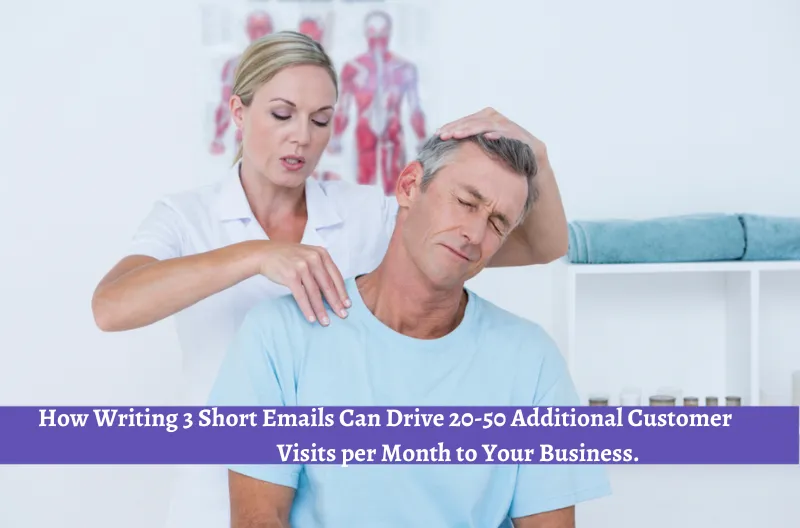
Written by Ross Bryant
Today I wanted to share a story that I heard about a few weeks ago. It's all about how a Chiropractor gets anywhere from 20-50 additional folks walking through his front doors and spending money on services (and how he does it every single month).
The Funny Part is how what he's doing is so simple but yet so effective.
"Now wait a minute," you say ... "I'm a Dentist, or a Real Estate agent, or a, or a ..." Just stay with me, I promise this works in all kinds of businesses, even yours!
I met Dr. Ben Adkins a few years back and he just recently told me the story of how he accidentally stumbled onto something he calls his "1 Email per Month Model" that worked so well for him (and has ended up working extremely well for everyone he's taught it to). Today, I'm going to walk you through his exact model so you can use it in your business. Trust me when I say that this is worth implementing in your business, even if you're not a Chiropractor.
The Story behind How Dr. Ben discovered the "Reactivation Blueprint" model.

Dr. Ben tells me that he first stumbled onto his email method when he was first starting out in practice and was actually sending out Physical Letters in the mail.
I'll Let him Tell You About it in His Own Words:
"It was funny. The first few years as a Chiropractor I would write a short letter and send it out to all my patients via physical mail. We did this once a month and, as we grew, it got really expensive. Between the paper, envelopes, and stamps, it got to be something that would cost us quite a bit of money."
"We kept doing it with old fashioned mail because, even though it was expensive, it always worked and it accounted for a lot of patient visits and new business each month.
That said, I am always looking for ways to cut costs. And then, it just hit me like a bolt of lightning one day. I needed to kill the physical mailers and just start emailing my monthly newsletters to my patients."
"I didn't know if it would translate to email but I thought we would give it a shot. We sent out our first email and within a few minutes of hitting the send button, the phone rang. It was a patient of ours that hadn't been in for a while but had gotten our newsletter and decided it was time to come back in for an adjustment."
"During the next few days we kept getting calls like this. The person would say that they had "just been thinking they needed to come back in" and then our email reminded them that they needed to call and book an appointment."
Dr. Ben told me that this ended up accounting for an additional 34 patient visits that month and it averages between 20-50 patient visits every month that they send the newsletter out. He went on to tell me that it was so effective in his practice that he had to hire someone to help him write everything because he had gotten so busy from all the new patient visits.
The Psychology of Why The Model Works.
The super weird thing about the emails that Dr. Ben sends out is that they rarely offer discounts or promotions and are successful because they draw people back into your business by serving as a sneaky excuse to remind folks that you still exist and that they love your business. The list of people that you send these emails out to are already customers and they are already fans of what you're doing in your business. All you need to do is send them a subtle reminder that you're still there and that you are open for business.

I don't care how cool your business is, people don't spend much time thinking about you as they battle their daily battles. This email system is a neat little way to remind folks that you're around and that they should give you a call (without coming right out and telling them to come back in or offering a discount for your product or services.)
How to Write and Send out the 3 Simple Emails that Dr. Adkins uses to Drive Business Each Month.
The trick to writing great emails that your customers/leads will open and take action on is to make sure that what you're putting inside of the email is something is something that will resonate with your audience and make them pick up the phone and call.
To do that we need to think about the psychology behind each email and what the effect of reading that email has on your clientele. But we’ll talk about that in a minute.
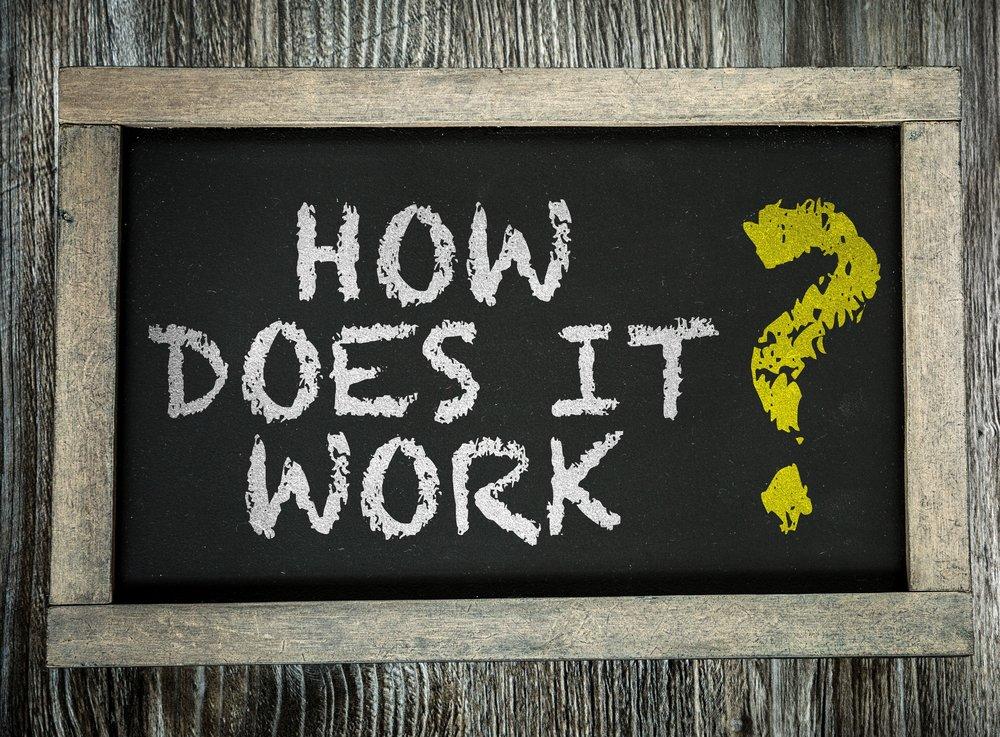
This process is based on a very simple contact template that induces people to respond without having to give the farm away … but if we don’t hear from them right away we are okay with giving away a little by the end of the campaign.
Now, most people that do reactivation campaigns think they have to do everything they did to get the patients in the first place: coupons, big discounts, etc., which is very expensive. But you don’t have to do that!
The Goal is to get People Back
And sometimes all that means is that we remind them we’re still here. These people already love you.
The Scripts Behind the Reactivation Blueprint
The template is basically 3 messages all following this script:
Dear CUSTOMER NAME
- Personal Intro (who is writing)
- Reason for mailing
- Educational "why to Come Back" (Carrot or Stick)
- Call to Action
This email, while looking quite personal, is really just a mail-merge from your existing data or word processor that inserts the customer’s name, is from someone actually in the office, tells them why you’re emailing (a little education as to why to come back) and then calling them to action.
To do this, we use a stair-step method to give your customers more of a reason to respond without hitting a tone of desperation.
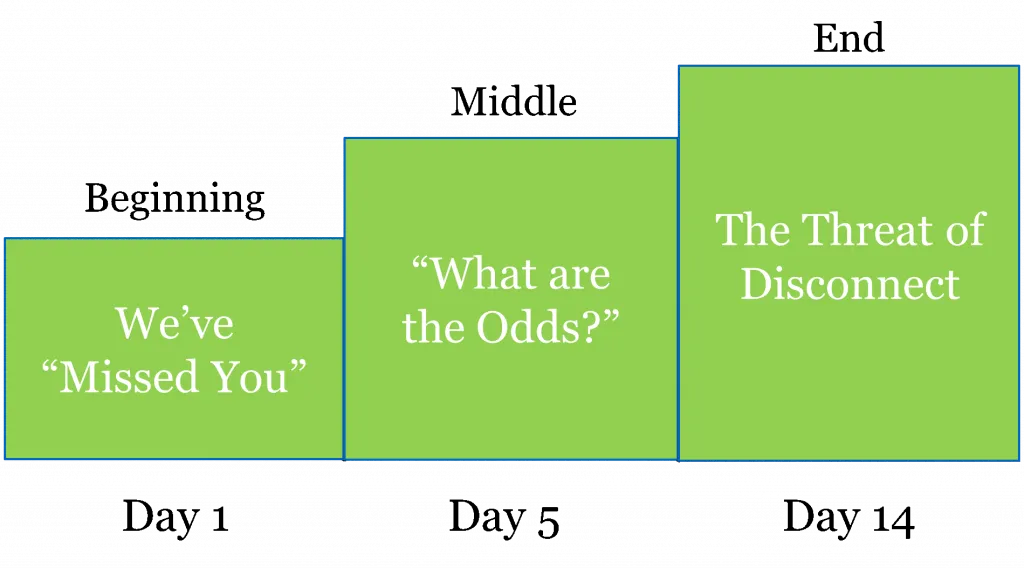
As we stated earlier, each of these messages hit different psychological triggers in your patient’s minds when they read these messages.
The Beginning
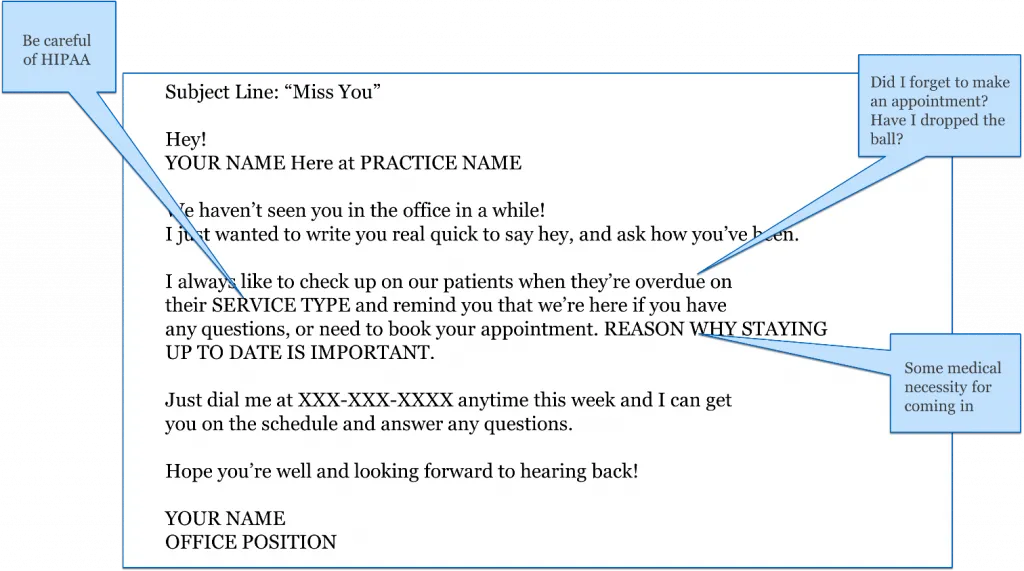
So, let’s break this down … first, the subject line is “Miss You.” Imagine you are a chiropractic patient, haven’t been back in a while, maybe quit a little early. Most chiropractors are very good about stressing the importance of completing their therapy for best results, so this email plays directly to that, “I just wanted to write and see how you’ve been.”
Did you see “overdue?” This plants the thought that your patient may be dropping the ball and reminds them that if they have any questions to just pick up the phone and call.
Finally, you must give them a reason why missing an appointment, or why being overdue on a checkup is important. Close it up with “Just dial me at … anytime this week and I can get you on the schedule.
Hope you’re well, looking forward to hearing back. Sounds very personal, doesn’t it? It’s not, but it’s caring, it’s a little personal, and it gives them a way to fix the issue.
The Middle
Should your patient not respond to the first message you send out, this email goes out 5 days after the first one.
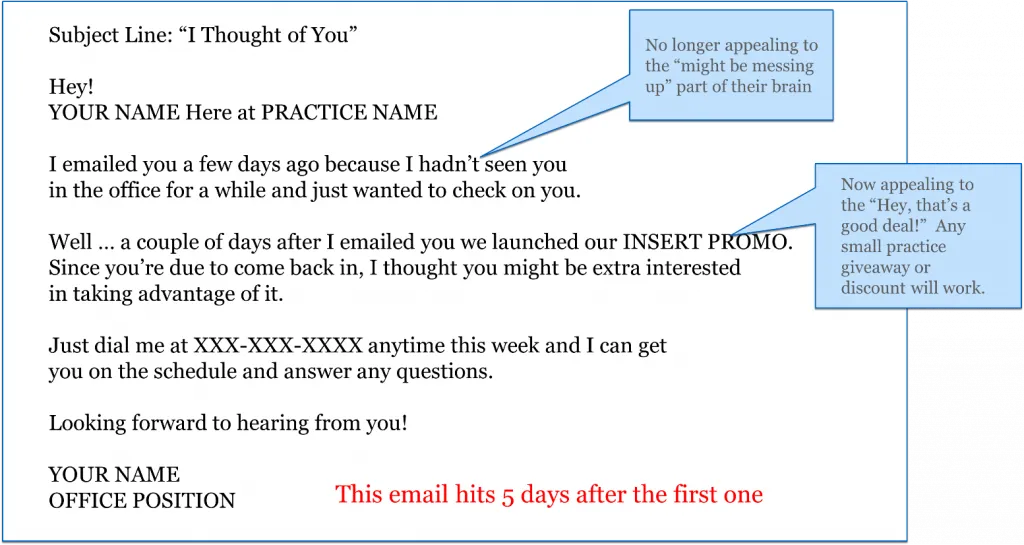
Important to remember here is that before this email goes out you need to gather a list of everyone that called in and remove them from the list that will receive this second email.
This message is kind of a “Oh, By the Way,” or a “I Thought of You” message. You just “happened” to launch a promo that you wanted them to know about. Now this promo would be something very inexpensive, maybe a free massage, whatever, but “since they were due to come back in anyway,” they might be extra-interested in taking advantage of that promotion.
In this message we are no longer appealing to the “might be messing up” aspect, but now to the “Hey! that’s a good deal” part of a person’s brain. Remember that this offer can be very small, or a percentage off something they may be interested in …remember they already love the business. A lot of the time when people do not respond to the first message it’s not that they don’t want to come in, they might’ve forgotten to call, or been busy. This is just a reminder or a little “carrot” to come on in.
The End
Now we wait until Day 14.
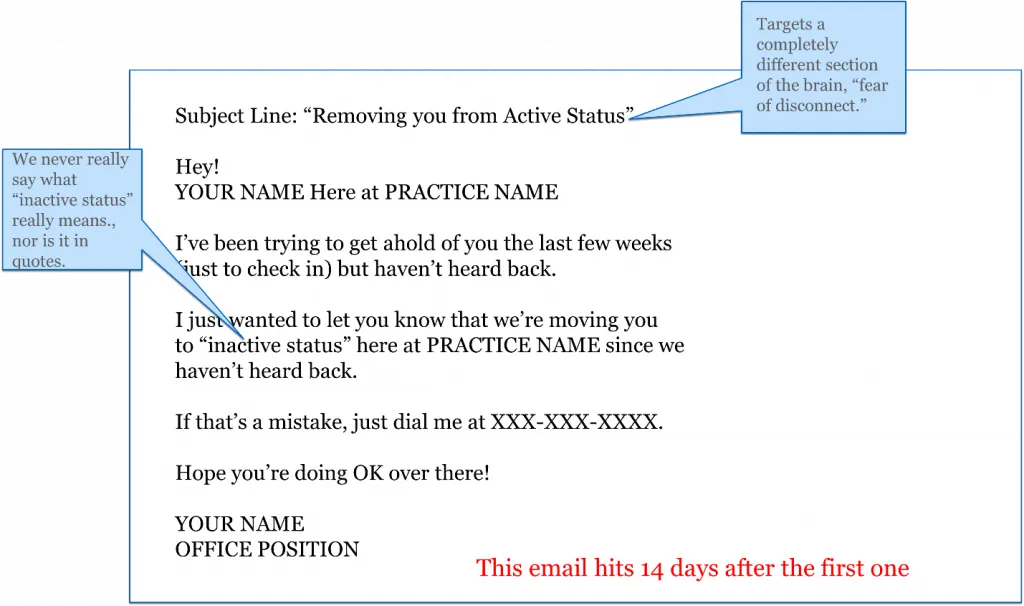
Again, we have to remember to pull any names off the list that did come in or called to schedule an appointment, because this email is the “Threat of Disconnect!”
Subject line jumps right out there with “Removing …” and goes immediately into “been trying to get ahold of you but haven’t heard back.” What is important here is that we never say just what “inactive status” is, just that we haven’t heard from them. We just want them to call.
Now typically, in a chiropractic office “inactive status” really means they’ll need a new exam, or need new x-rays, but we don’t want to explain that here. Again, we just want them to call.
Why Do Emails like the examples above work so much better to get a business’ phone ringing?
The above email style works because:
- Each email is individually designed to target specific points of the client’s psychology at each point of the cycle.
- It drives the reader to take action.
- It's about reminding your customers that you are still there and that you care about them.
- The "Call to Action" at the end is topical without being pushy.
When you build out content like this, people will open it and immediately have a "good feeling" about the person who sent it (who they already like because they are existing customers). This leads to them wanting to come back in and do business with you.
But What If You Don’t Have a List?
You’ve never collected emails, or are just now realizing the importance of using some different marketing channels to grow your practice.
HealthBeat Online can help design a program to collect and store those emails so they can be used in various ways.
Here’s how you do it:
- Start by re-designing your intake paperwork to capture the email addresses of new customers.
- If you need help getting those forms posted on your website, just let us know … we’re happy to help.
- Start sending the following emails to new patients when they come in to get them used to receiving emails from you.
A Chiropractic Example
Subject Line: “Just Wanted to Remind You”
Hey! It’s Dr Alex.
I just wanted to say how great it was meeting you today.
I chatted with you a bit before you left today but wanted to remind you of a couple of things:
Make sure that you ice tonight. (20 minutes on and 40 off).
The ice will help with soreness but there is a good chance you’re going to have some soreness stick around.
The first time you get adjusted is always the hardest. Your body is trying to adapt and it’s normal to be sore and sometimes you can even feel a little worse at first (that is expected).
If you have any questions tonight feel free to call or text me at 555-555-5555 (my personal cell phone)
I’ll see you at your next appointment. I’m going to explain what we found today and make sure we have a good plan to not only take care of what you came in for…. but also make sure we get you setup so that you can manage it on your own.
Have a great night,
Dr Alex
So… How do you get this going in your business without having to do any of the hard work to create the content or setup the tech?

Let Us Do It For You!
You might be like a lot of my clients that I do work for. You're a business owner that realizes how profitable it is to do advertising, send out emails, maintain a blog, etc., but you don't have the time and/or desire to do it yourself.
If you'd like to have us do some or all of it for you, just contact me at 423-564-5960 or email at [email protected]. We can do everything for you for very inexpensively and help you get the same kind of benefits being seen by our other clients.

Our founder, Ross Bryant, is a veteran of the software and internet technologies market with over 20 years experience in the healthcare and healthcare IT space and has been writing and publishing content for many years. Working with many different companies, in physician, hospital, and pharmacy offices, has given him the insight to understand your needs and the experience to develop the product sets that can help you market your practice.
Your Marketing People
Delivering Facebook consulting, Social media content management, promotional marketing, and other services to the business community.
